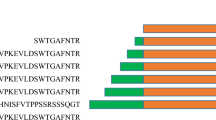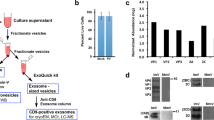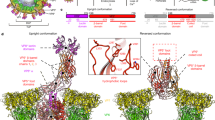Summary
A large proportion of host cell-bound virions of poliovirus type 1 strain Mahoney (PV1/M) is known to elute to the culture medium during incubation at 37 °C, and only a fraction of the virions remaining cell-associated will successfully uncoat and contribute to the new replication cycle. We found that while the proportion of inoculum type 3 poliovirus strain Saukett (PV3/S) bound to GMK cells was of the same order as that of PV1/M, the bound PV3/S virions uncoated much less efficiently, as judged by velocity sedimentation analysis of virion disintegration. Rather, the majority of the cell-associated PV3/S viruses remained apparently unaffected for several hours within an unidentified intracellular compartment. Incubation of PV3/S with intestinal trypsin is known to result in selective cleavage of the capsid protein VP1 and striking antigenic changes. Trypsin treatment of stock PV3/S preparations did not affect the infectivity titre or modify single-cycle progeny virus yields significantly. However, the fate of the cell-bound inoculum virus was profoundly altered. Trypsin-treated PV3/S virions (PV3/S-Try) attached to GMK cells less tightly than the untreated PV3/S virus or PV1/M, and a relatively larger proportion of the cell-bound virus eluted to the medium during subsequent incubation at 36 °C. However, the fraction of virions remaining cell-associated rapidly disintegrated suggesting efficient uncoating. In accordance with these observations, one step growth curves of PV3/S-Try in all cell lines tested showed lowered eclipse phase titres compared to those obtained with the untreated PV3/S inocula. Similar effects were also demonstrated for type 3 poliovirus strain Sabin while trypsin-sensitive strains of the other two serotypes of poliovirus remained unaffected in this sense. The putative biological significance of the altered sorting of cell-bound PV3/S-Try virions is not known. It might be related to the observations that sensitivity of type 3 poliovirus strains to trypsin is conserved in spite of the fact that the target site of trypsin action is flanked by highly variable motives in an immunodominant antigenic site.
Similar content being viewed by others
References
Filman DJ, Syed R, Chow M, MacAdam AJ, Minor PD, Hogle JM (1989) Structural factors that control conformational transitions and serotype specificity in type 3 poliovirus. EMBO J 8: 1567–1579
Fricks CE, Icenogle JP, Hogle JM (1985) Trypsin sensitivity of the Sabin strain of type 1 poliovirus: cleavage sites in virions and related particles. J Virol 54: 856–859
Fricks CE, Hogle JM (1990) Cell-induced conformational change in poliovirus: externalization of the amino terminus of VP1 is responsible for liposome binding. J Virol 64: 1934–1945
Hogle JM, Chow M, Filman J (1985) Three dimensional structure of poliovirus at 2.9 Å resolution. Science 229: 1358–1365
Hovi T, Roivainen M, Airaksinen A, Piirainen L (1992) Effect of host proteases on early steps of enterovirus infection. In: Korhonen T, Hovi T, Mäkelä PH (eds) Molecular recognition in host-parasite interactions. Plenum Press, New York, pp 191–200 (FEMS Symposium No. 61)
Icenogle JP, Minor PD, Ferguson M, Hogle JM (1986) Modulation of humoral response to a 12-amino acid site on the poliovirus virion. J Virol 60: 297–301
Kaplan G, Peters D, Racaniello VR (1990) Poliovirus mutants resistant to neutralization with soluble cell receptors. Science 250: 1596–1599
Kronenberger P, Vrijsen R, Boeye A (1994) Intracellular proteolysis of poliovirus eclipse particles is abortive. J Gen Virol 75: 473–580
Martin A, Wychowski C, Couderc T, Crainic R, Hogle J, Girard M (1988) Engineering a poliovirus type 2 antigenic site on a type 1 capsid results in a chimaeric virus which is neurovirulent for mice. EMBO J 7: 2839–2847
Mendelsohn CL, Wimmer E, Racaniello VR (1989) Cellular receptor for poliovirus: molecular cloning, nucleotide sequence, and expression of a new member of the immunoglobulin superfamily. Cell 56: 855–865
Minor PD, Ferguson M, Phillips A, Magrath DI, Huovilainen A, Hovi T (1987) Conservation in vivo of protease cleavage sites in antigenic sites of polioviruses. J Gen Virol 68: 1857–1865
Moscufo N, Yafal AG, Rogove A, Hogle J, Chow M (1993) A mutation in VP4 defines a new step in the late stages of cell entry by poliovirus. J Virol 67: 5075–5078
Moss EG, Racaniello VR (1991) Host range determinants located on the interior of the poliovirus capsid. EMBO J 10: 1067–1074
Murray MG, Bradley J, Yang X-F, Wimmer E, Moss EG, Racaniello VR (1988) Poliovirus host range is determined by a short amino acid sequence in neutralization antigenic site 1. Science 241: 213–215
Nobis P, Zibirre R, Meyer G, Kühne J, Warnecke G, Koch G (1985) Production of a monoclonal antibody against an epitope on HeLa cells that is the functional poliovirus binding site. J Gen Virol 66: 2563–2569
Roivainen M, Hovi T (1988) Cleavage of VP1 and modification of antigenic site 1 of type 2 poliovirus by intestinal trypsin. J Virol 62: 3536–3539
Roivainen M, Huovilainen A, Hovi T (1990a) Antigenic modification of polioviruses by host proteolytic enzymes. Arch Virol 111: 115–125
Roivainen M, Montagnon B, Chalumeau H, Murray M, Wimmer E, Hovi T (1990b) Improved distribution of antigenic site specificity of poliovirus-neutralizing antibodies induced by a protease-cleaved immunogen in mice. J Virol 64: 559–562
Roivainen M, Hyypiä T, Piirainen L, Stanway G, Hovi T (1991) RGD-dependent entry of coxsackievirus A9 to host cells and its bypass after cleavage of VP1 protein by intestinal proteases. J Virol 65: 4735–4740
Shepley MP, Sherry B, Weiner HL (1988) Monoclonal antibody identification of a 100-kDa membrane protein in HeLa cells and human spinal cord involved in poliovirus attachment. Proc Natl Acad Sci USA 85: 7743–7747
Shepley MP, Racaniello VR (1994) A monoclonal antibody that blocks poliovirus attachment recognixes the lymphocyte homing receptor CD44. J Virol 68: 1301–1308
Author information
Authors and Affiliations
Rights and permissions
About this article
Cite this article
Piirainen, L., Airaksinen, A., Hovi, T. et al. Selective cleavage by trypsin of the capsid protein VP1 of type 3 poliovirus results in improved sorting of cell bound virions. Archives of Virology 141, 1011–1020 (1996). https://doi.org/10.1007/BF01718605
Received:
Accepted:
Issue Date:
DOI: https://doi.org/10.1007/BF01718605




